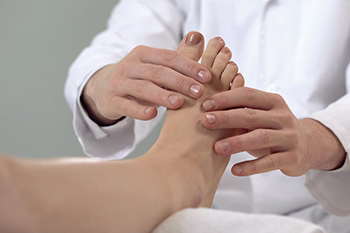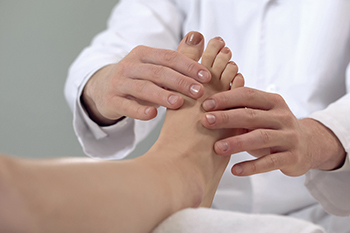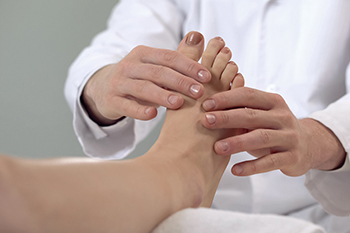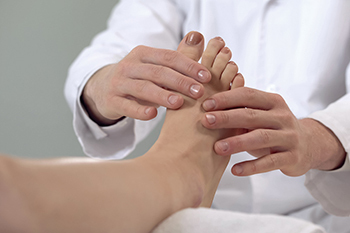283 St Rose Ave
Windsor, ON N8S 1X1
September 2022
Why Ankle Pain Occurs

Having ankle pain is a good indicator that an injury has happened to the ankle bone or the surrounding joints. The ankle is in the perfect position where the foot bones and leg connect. There are three joints in the ankle, and each has a function. These functions include providing stability to hold the body’s weight, moving the body forward while walking or running, and providing shock absorption for daily movements. Common symptoms that can accompany ankle pain is the inability to walk, swelling, and the ankle can have a throbbing or tingling sensation. The pain from an Achilles tendon injury may travel to the ankle and can make it difficult to complete daily activities. Additional reasons why ankle pain occurs include having arthritis, bursitis, edema, or an ankle fracture. Many times, there is a distinctive reason why ankle pain exists, so it is strongly suggested that a podiatrist be consulted who can perform a proper diagnosis and treat your ankle pain.
Ankle pain can have many different causes and the pain may potentially be serious. If you have ankle pain, consult with the practitioners from Foot Care Institute. Our practitioners will assess your condition and provide you with quality foot and ankle treatment.
Ankle pain is any condition that causes pain in the ankle. Due to the fact that the ankle consists of tendons, muscles, bones, and ligaments, ankle pain can come from a number of different conditions.
Causes
The most common causes of ankle pain include:
- Types of arthritis (rheumatoid, osteoarthritis, and gout)
- Ankle sprains
- Broken ankles
- Achilles tendinitis
- Achilles tendon rupture
- Stress fractures
- Tarsal tunnel syndrome
- Plantar fasciitis
Symptoms
Symptoms of ankle injury vary based upon the condition. Pain may include general pain and discomfort, swelling, aching, redness, bruising, burning or stabbing sensations, and/or loss of sensation.
Diagnosis
Due to the wide variety of potential causes of ankle pain, podiatrists will utilize a number of different methods to properly diagnose ankle pain. This can include asking for personal and family medical histories and of any recent injuries. Further diagnosis may include sensation tests, a physical examination, and potentially x-rays or other imaging tests.
Treatment
Just as the range of causes varies widely, so do treatments. Some more common treatments are rest, ice packs, keeping pressure off the foot, orthotics and braces, medication for inflammation and pain, and surgery.
If you have any questions, please feel free to contact our office located in Windsor, ON . We offer the newest diagnostic and treatment technologies for all your foot care needs.
Foot Structure and Bunions

Research has indicated that the foot condition known as a bunion may be inherited. Furthermore, studies have shown the bunion itself has not developed because of genetic reasons, but the foot structure that contributed to it may be inherited. It is easy to notice the bony protrusion on the big toe’s side. Some people develop bunions if they have endured a traumatic foot injury, which may also contribute to changes in the foot structure. There may be existing medical conditions like arthritis, multiple sclerosis, or cerebral palsy that can lead to a bunion. A common reason why many patients develop bunions can be the type of shoes that are worn. High heels and shoes that do not have adequate room for the toes to move freely in may cause a bunion. This particular foot condition is considered to be a deformity, and it is suggested that you confer with a podiatrist who can guide you toward correct treatment methods.
If you are suffering from bunions, contact the practitioners of Foot Care Institute. Our practitioners can provide the care you need to keep you pain-free and on your feet.
What Is a Bunion?
A bunion is formed of swollen tissue or an enlargement of boney growth, usually located at the base joint of the toe that connects to the foot. The swelling occurs due to the bones in the big toe shifting inward, which impacts the other toes of the foot. This causes the area around the base of the big toe to become inflamed and painful.
Why Do Bunions Form?
Genetics – Susceptibility to bunions are often hereditary
Stress on the feet – Poorly fitted and uncomfortable footwear that places stress on feet, such as heels, can worsen existing bunions
How Are Bunions Diagnosed?
Doctors often perform two tests – blood tests and x-rays – when trying to diagnose bunions, especially in the early stages of development. Blood tests help determine if the foot pain is being caused by something else, such as arthritis, while x-rays provide a clear picture of your bone structure to your doctor.
How Are Bunions Treated?
- Refrain from wearing heels or similar shoes that cause discomfort
- Select wider shoes that can provide more comfort and reduce pain
- Anti-inflammatory and pain management drugs
- Orthotics or foot inserts
- Surgery
If you have any questions, please feel free to contact our office located in Windsor, ON . We offer the newest diagnostic and treatment technologies for all your foot care needs.
What Does Foot Drop Mean?

Foot drop is a symptom of another condition, generally related to some form of nerve injury. It becomes apparent when a patient is unable to lift the foot enough to clear the floor or ground while walking. The foot then drags along behind, causing a type of shuffling gait. Someone with foot drop may raise the knee higher with each step, which looks like marching. Further, the foot often slaps the ground when it is lowered, as the patient is unable to control the movement. Among the many conditions that result in foot drop are a peroneal nerve injury, an ankle injury, muscular dystrophy, a stroke, or diabetes. Even something as simple as crossing the legs while sitting can constrict the peroneal nerve and cause numbness and foot drop. A podiatrist can conduct a complete examination to determine the cause of foot drop and explore the range of treatment options available to you.
If you have any concerns about your feet, contact the practitioners from Foot Care Institute. Our practitioners can provide the care you need to keep you pain-free and on your feet.
Biomechanics in Podiatry
Podiatric biomechanics is a particular sector of specialty podiatry with licensed practitioners who are trained to diagnose and treat conditions affecting the foot, ankle and lower leg. Biomechanics deals with the forces that act against the body, causing an interference with the biological structures. It focuses on the movement of the ankle, the foot and the forces that interact with them.
A History of Biomechanics
- Biomechanics dates back to the BC era in Egypt where evidence of professional foot care has been recorded.
- In 1974, biomechanics gained a higher profile from the studies of Merton Root, who claimed that by changing or controlling the forces between the ankle and the foot, corrections or conditions could be implemented to gain strength and coordination in the area.
Modern technological improvements are based on past theories and therapeutic processes that provide a better understanding of podiatric concepts for biomechanics. Computers can provide accurate information about the forces and patterns of the feet and lower legs.
Understanding biomechanics of the feet can help improve and eliminate pain, stopping further stress to the foot.
If you have any questions please feel free to contact our office located in Windsor, ON . We offer the newest diagnostic and treatment technologies for all your foot and ankle needs.
Arthritis Can Cause Pain in the Feet and Ankles
How Your Diet Can Contribute to Gout

Gout is a form of arthritis that occurs when crystals formed by uric acid cause painful inflammation in the joints, commonly the big toe. People typically develop gout because their body does not efficiently flush out excess uric acid through the kidneys. Certain foods contribute to the onset of gout. The top contenders are certain types of meat and seafood. In addition, alcoholic beverages like beer and sugary drinks can contribute to gout. Foods that are high in cholesterol are also believed to increase the risk of developing gout. Eating foods high in purines is not the only way to build up too much uric acid, called hyperuricemia. Poor kidney function is thought to be a factor too. If you are experiencing pain in the joint of the big toe along with redness and swelling, you may have gout. It is suggested that you contact a podiatrist who can examine the area, diagnose the cause, and offer treatment solutions.
Gout is a foot condition that requires certain treatment and care. If you are seeking treatment, contact the practitioners from Foot Care Institute. Our practitioners will treat your foot and ankle needs.
What Is Gout?
Gout is a type of arthritis caused by a buildup of uric acid in the bloodstream. It often develops in the foot, especially the big toe area, although it can manifest in other parts of the body as well. Gout can make walking and standing very painful and is especially common in diabetics and the obese.
People typically get gout because of a poor diet. Genetic predisposition is also a factor. The children of parents who have had gout frequently have a chance of developing it themselves.
Gout can easily be identified by redness and inflammation of the big toe and the surrounding areas of the foot. Other symptoms include extreme fatigue, joint pain, and running high fevers. Sometimes corticosteroid drugs can be prescribed to treat gout, but the best way to combat this disease is to get more exercise and eat a better diet.
If you have any questions please feel free to contact our office located in Windsor, ON . We offer the newest diagnostic and treatment technologies for all your foot and ankle needs.









